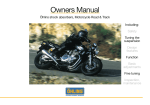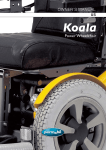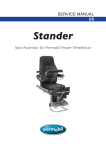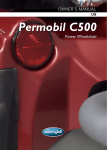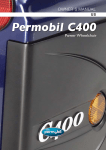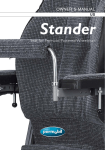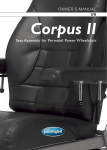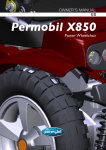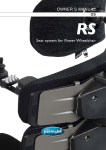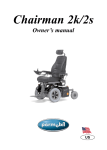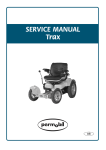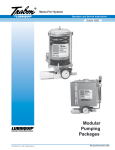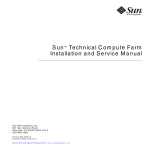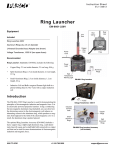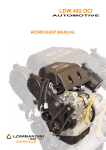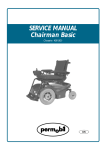Download Permobil Trax
Transcript
TRAX Owner´s manual US How to contact Permobil Permobil Inc. USA 6961 Eastgate Blvd. Lebanon, TN 37090 USA Phone: 800-736-0925 Fax: 800-231-3256 Email: [email protected] Permobil Group Head Office Permobil AB Box 120, 861 23 Timrå, Sweden Tel: +46 60 59 59 00. Fax: +46 60 57 52 50 E-mail: [email protected] Prepared and published by Permobil AB, Sweden. Edition 3, 2006-01 Order no. 201083-US-0 -3- Owner´s manual Trax Contents Contents General introduction . . . . . . . . . . . . . . . . . . . . . . . . . . . . . . . . . . . .6 Specially adapted wheelchairs . . . . . . . . . . . . . . . . . . . . . . . . . . 6 Safety Instructions . . . . . . . . . . . . . . . . . . . . . . . . . . . . . . . . . . . . .7 Design and function . . . . . . . . . . . . . . . . . . . . . . . . . . . . . . . . . .10 General . . . . . . . . . . . . . . . . . . . . . . . . . . . . . . . . . . . . . . . . . . .10 Chassis . . . . . . . . . . . . . . . . . . . . . . . . . . . . . . . . . . . . . . . . . . .10 Seat . . . . . . . . . . . . . . . . . . . . . . . . . . . . . . . . . . . . . . . . . . . . . 11 Seat lift . . . . . . . . . . . . . . . . . . . . . . . . . . . . . . . . . . . . . . . . . . . .11 Wheels . . . . . . . . . . . . . . . . . . . . . . . . . . . . . . . . . . . . . . . . . . . .12 Lighting/reflectors . . . . . . . . . . . . . . . . . . . . . . . . . . . . . . . . . .12 Electrical system . . . . . . . . . . . . . . . . . . . . . . . . . . . . . . . . . . .13 Control panel . . . . . . . . . . . . . . . . . . . . . . . . . . . . . . . . . . . . . . .15 Joystick menu . . . . . . . . . . . . . . . . . . . . . . . . . . . . . . . . . . . . . .20 Accessories . . . . . . . . . . . . . . . . . . . . . . . . . . . . . . . . . . . . . . . . .23 Tool wallet . . . . . . . . . . . . . . . . . . . . . . . . . . . . . . . . . . . . . . . . .23 Bow, luggage basket, crutch holder etc. . . . . . . . . . . . . . . . . . .24 Operation . . . . . . . . . . . . . . . . . . . . . . . . . . . . . . . . . . . . . . . . . . . .25 General . . . . . . . . . . . . . . . . . . . . . . . . . . . . . . . . . . . . . . . . . .25 Driving . . . . . . . . . . . . . . . . . . . . . . . . . . . . . . . . . . . . . . . . . . .25 Driving rules . . . . . . . . . . . . . . . . . . . . . . . . . . . . . . . . . . . . . . .29 Releasing the brakes . . . . . . . . . . . . . . . . . . . . . . . . . . . . . . . .32 Charging the batteries . . . . . . . . . . . . . . . . . . . . . . . . . . . . . . . 33 Transport . . . . . . . . . . . . . . . . . . . . . . . . . . . . . . . . . . . . . . . . . . . .35 Air transport . . . . . . . . . . . . . . . . . . . . . . . . . . . . . . . . . . . . . . .36 Preventive maintenance . . . . . . . . . . . . . . . . . . . . . . . . . . . . . . .37 General . . . . . . . . . . . . . . . . . . . . . . . . . . . . . . . . . . . . . . . . . . .37 Cleaning . . . . . . . . . . . . . . . . . . . . . . . . . . . . . . . . . . . . . . . . . .38 Wheels . . . . . . . . . . . . . . . . . . . . . . . . . . . . . . . . . . . . . . . . . .38 Batteries . . . . . . . . . . . . . . . . . . . . . . . . . . . . . . . . . . . . . . . . . .38 Repairs . . . . . . . . . . . . . . . . . . . . . . . . . . . . . . . . . . . . . . . . . . . . .39 Resetting the main fuse/circuit breaker . . . . . . . . . . . . . . . . . .39 Changing fuses . . . . . . . . . . . . . . . . . . . . . . . . . . . . . . . . . . . .41 Changing batteries . . . . . . . . . . . . . . . . . . . . . . . . . . . . . . . . . .42 Changing inner tubes . . . . . . . . . . . . . . . . . . . . . . . . . . . . . . . .43 Filling with air . . . . . . . . . . . . . . . . . . . . . . . . . . . . . . . . . . . . . .44 Labels . . . . . . . . . . . . . . . . . . . . . . . . . . . . . . . . . . . . . . . . . . . . . . .45 Specifications . . . . . . . . . . . . . . . . . . . . . . . . . . . . . . . . . . . . . . . .47 Electrical system . . . . . . . . . . . . . . . . . . . . . . . . . . . . . . . . . . . . . .48 -4- Contents Owner´s manual Trax Contents Trax seat General introduction . . . . . . . . . . . . . . . . . . . . . . . . . . . . . . . . . . .50 Safety Instructions . . . . . . . . . . . . . . . . . . . . . . . . . . . . . . . . . . . .50 Specially adapted product . . . . . . . . . . . . . . . . . . . . . . . . . . . . 50 Design and function . . . . . . . . . . . . . . . . . . . . . . . . . . . . . . . . . .51 General . . . . . . . . . . . . . . . . . . . . . . . . . . . . . . . . . . . . . . . . . . .51 Seat . . . . . . . . . . . . . . . . . . . . . . . . . . . . . . . . . . . . . . . . . . . . . 52 Back rest . . . . . . . . . . . . . . . . . . . . . . . . . . . . . . . . . . . . . . . . . .52 Arm rests . . . . . . . . . . . . . . . . . . . . . . . . . . . . . . . . . . . . . . . . . .52 Accessories . . . . . . . . . . . . . . . . . . . . . . . . . . . . . . . . . . . . . . . . . .52 Adjusting the settings . . . . . . . . . . . . . . . . . . . . . . . . . . . . . . . . . .53 Seat angle . . . . . . . . . . . . . . . . . . . . . . . . . . . . . . . . . . . . . . . . .53 Arm rest . . . . . . . . . . . . . . . . . . . . . . . . . . . . . . . . . . . . . . . . . . .54 Maintenance and transport . . . . . . . . . . . . . . . . . . . . . . . . . . . . . .55 Technical specifications . . . . . . . . . . . . . . . . . . . . . . . . . . . . . . . .56 Important Information (only for the US-market) -5- . . . . . . . . . . . . . . .58-59 Owner´s manual Trax General introduction General introduction In order to get the best possible use from your wheelchair, it is important to use it in the intended way. We therefore advise you to carefully read the operating instructions, especially the safety instructions. Keep the operating instructions with the rest of the things belonging to the chair. The first thing you should do is to charge the batteries. If you’re not sure what to do, read the chapter on Battery charging on pages 33-34. Charging takes about ten hours. Specially modified wheelchairs If your wheelchair is marked with a “Specially modified product” sticker, it has been modified to your specific needs and wishes. This means that the design and functions could be different from the text in these operating instructions, or the design and functions of other wheelchairs of the same type. The seat can also contain parts that are unique to your chair. These aren’t available as spare parts, and must be made as required. This can affect the repair time of your seat. Specifcations All information and specifications given in these operating instructions where applicable when this wheelchair was delivered. As Permobil carries out continual development and improvement, we reserve the right to make changes without prior notice. -6- Owner´s manual Trax Safety instructions Safety instructions General A wheelchair is a motor-driven vehicle, so be very careful when using it. Incorrect use can cause a risk of injury or damage to the chair. To reduce these risks, you should read the operating instructions carefully, especially the safety instructions and warnings. Any improper modification of the wheelchair and its systems may increase the risk of accident. Follow the recommendations in the section on Operation in order to avoid risks when driving. All modifications to, and interference with, the key systems of the wheelchair should be done by qualified servicing engineers. Always contact a qualified service engineer in case of doubt. Warning Wherever you see this warning symbol, take special care. There could be a risk of personal injury. Maximum weight of user The wheelchair is designed for one person with a maximum weight of 298 Ibs. If the wheelchair is fitted with a seat lift, the maximum user weight is 220 Ibs. Passengers It is absolutely forbidden to carry passengers on the wheelchair. Operation Do not let children drive the wheelchair without supervision. Do not drive the wheelchair over any edges higher than 4,5 inches. When driving downhill, select the slowest speed and take great care. The wheelchair is not designed for driving down slopes with a gradient greater than 15°. Do not drive up slopes with a gradient greater than 15°. There is a risk that the wheelchair will not maneuver safely. Do not drive the wheelchair where the sideways gradient is more than 12°. There is a risk of tipping over. -7- Owner´s manual Trax Safety precautions Opeating the seat lift Make sure nothing gets jammed between the chassis and the seat when you are operating the seat lift. The center of gravity is higher when the seat is raised, increasing the risk of tipping. So use the seat lift only on flat ground and not on uneven surfaces. Releasing the brakes Make sure the wheelchair is on a level surface before you release the brakes, so it doesn’t roll away. If the wheelchair is fitted with servo-steering, it will not be possible to steer it electrically once the brakes are released. The wheelchair can be steered manually by turning the front wheels directly by hand. Charging the batteries Charging should be done in a well-ventilated area, not in a wardrobe or closet. You should not charge the batteries in a bathroom or wet area. Only use a charger with a maximum charging current of 15A. You should not try to drive the chair when the charger is connected, since this will not work. Transport Ensure that the chair is properly secured (see page 35). A chair that is not properly secured can cause injury and damage if it comes loose. -8- Owner´s manual Trax Safety precautions Servicing Only attempt the servicing and maintenance that the operating instructions say may be done by the user. All other servicing and maintenance should be done by someone with sufficient knowledge to be able to do it correctly. Always disconnect the positive terminal of the battery before you work on the electrical system of the wheelchair. Take care when using metal objects while working on the battery. A short circuit could easily cause an explosion. Always use protective gloves and glasses. The recommended air pressure is 36 psi. The tire could explode if you over-inflate it. -9- Owner´s manual Trax Design and Function Design and Function General 1 2 3 4 7 6 5 1. Seat (Trax seat) 5. Rear wheel/drive wheel 2. Control panel 6. Front wheel 3. Chassis 7. Chassis cover 4. Foot rest Fig. 1. Electric wheelchair Trax - 10 - Owner´s manual Trax Design and Function Seat See enclosed seat instructions (Trax) or the supplied Owner’s Manual for the seat (CorpusII/Miniflex). Seat lift/seat twist Trax is fitted with an electrically controlled seat lift or a fixed seating pillar. A position adjuster operated from the control panel allows continuous adjustment of the seat to any height between 20-29 inches, permitting simple matching with table, seat heights etc. Whenever the seat lift is raised from its lowest position the chair's maximum forward speed is lowered to 4 miles/h and the maximum reverse speed to 2,5 miles/h. The seat lift function is only operative when the wheelchair is stationary. Both electric seat twist and manual seat twist are possible (not Miniflex). The seat is mounted to twist to the right or the left, see Fig. 2. Make sure nothing is trapped between the chassis and the seat when operating the seat lift. Use of the seat twist function must take place only on a level surface. Release lever for manual seat twist Fig. 2. Manual seat twist - 11 - Design and Function Owner´s manual Trax Seat angle Front The seat angle can be set in three different positions, forward-leaning, neutral and backward-leaning. If the seat is equipped with seat twist, the seat must be in neutral, i.e. level, position. The seat angle is set by means of the holes under the seat. There are three holes under the seat at the front and three at the back, see fig. 3. A level position is obtained by mounting screws in the equivalent row of holes front and back. For more information, read the user instructions for your seat. Fig. 3. Trax seat in neutral position (level) Lengthways adjustment The wheelchair has electric or manual lengthways adjustment. The length of the wheelchair can be adjusted by up to 8 inches, see page 18, 28. light Wheels The wheelchair has pneumatic tires. Lighting and reflectors In the standard version, the wheelchair is equipped with lights, direction indicators and reflectors back and front. For more information on lighting and blinkers, see pages 16-17. light Fig. 4 Lighting and reflectors - 12 - Design and Function Owner´s manual Trax Electrical system The wheelchair batteries are situated under the battery cover in the center of the chassis. The batteries are maintenance-free (gel-type), so there is no need to check fluid levels. Fig. 5. Batteries Drive system The wheelchair has a drive pack for each drive wheel. The motors regulate speed and braking and activate turning. A joystick on the control panel passes signals to the electronic unit situated centrally under the chassis cover at the far rear, and this in turn controls the motors. Electric motor Fig. 6. Electric motor - 13 - Design and Function Owner´s manual Trax Fuses The wheelchair has four fuses, the main fuse, the charging fuse, the fuse for the position adjuster and that for lighting/direction indicators.The main fuse is mounted at the right-hand front of the battery box, while the other three are located below the junction box. The fuses are easily accessible between the shock absorbers at the rear of the wheelchair.To change the fuses, see page 41. On Off 1 Center Main fuse The main fuse is tripped when the toggle switch is turned away from the chassis center, see fig. 7.1. Press the switch back towards the chassis center to reset the main fuse. See "Resetting the main fuse", pages 39-40. 2 1. 3 4 Main fuse 100A 2. Charging fuse 20A 3. Position adjuster 15A 4. Lighting/indicators 7,5A NB! Under very specific circumstances, the fuses in the Safe Gate electronics may cut off the power supply. This will require checking by a service engineer before the fuses are changed. Fuses in the junction box 5 6 7 Safe Gate electronics 5. Lighting/indicators 30A Safe Gate electronics 6. Position adjuster 30A Fig. 7 . Fuses 7. Charging fuse 30A - 14 - Owner´s manual Trax Design and Function Control panel The wheelchair control panel is fixed to the right or left-hand arm rest, with adjustable location on the panel holder for optimum ease of use. The illustration below shows the different control panel functions. 1 2 3 4 5 8 6 7 9 10 Fig. 8. Control panel 1. Lighting 6. Horn 2. Direction Indicators 7. Speed selector (low, medium, high) 3. Seat lift 8. Joystick 4. On/off switch 9. Start key 5. Battery voltage indicator 10. Button box - 15 - Owner´s manual Trax Design and Function Start key The start key is a plug device which is inserted into the control panel. The key must be inserted before the main switch can be activated. Fig. 9. Start key Main switch The main switch acts as an on/off switch for power to the wheelchair and must be set to "on" before the chair will operate. NB! First switch off the power on the maneuvering panel (switch marked "0") before switching the power off on the main fuse. + - Fig. 10. Main switch Seat lift The switch for moving the seat lift up and down. When the seat lift is in operation, the indicator lamp (Fig. 11) lights. Whenever the seat lift is raised from its lowest level, maximum speed is reduced by half (approx. 4,5 miles/h, 7 km/h). + - Fig. 11. Seat lift switch Direction indicators Pressing the direction indicator symbols will activate the right or lefthand direction indicator. A second press on the same symbol will stop the indicators flashing. + - Fig. 12. Direction indicator switch - 16 - Owner´s manual Trax Design and Function Lighting The lights will be turned on when the lighting symbol is pressed. A second press will turn them off again. Horn Pressing this switch sounds the horn to attract the attention of other road users. + - Fig. 13. Horn switch Battery voltage indicator The window display on the control panel (Fig. 14) indicates the following (left to right): Red/yellow/green = Fully charged Red/yellow = Half charged Red = Recharge batteries + - Fig. 14. Battery voltage indicator Speed selector The speed can be set at three levels, with one or more of the indicator lamps lighting up, depending on the speed range selected. + - 1 lamp lit = Low speed 2 lamps lit = Medium speed 3 lamps lit = Maximum speed Fig. 15. Speed selector - 17 - Owner´s manual Trax Design and Function Small control box The small control box is attached to the right or left-hand armrest behind the control panel. The small control box contains the various options such as wheelchair lengthways adjustment, seat twist (if equipped) and backrest angle. The pictures below show the different functions of the small control box and its location. Back rest angle (Corpus II only) The backrest can be angled back to the user's desired position. Pressing the top part of the switch causes the back to rise up. The back can be lowered by pressing the lower part of the switch. Back rest slope angle can be continuously adjusted backwards to 130°. Lengthways adjustment The distance between the foot rest and the seat can be adjusted. Pressing the upper part of the symbol causes the footrest to move outward, while it moves back again if the lower part is pressed. This makes it easy to adjust the chair to the user's leg length and allows the legs to be stretched during driving. Extending the foot rest completely gives a smoother ride outdoors. Retracting it makes driving round the house more convenient. More information on page 28. Fig. 16. Back rest angle Seat twist The seat twist enables the seat to be twisted out. This makes it easier to get on and off the seat. When seat twist is activated, a lamp lights above the seat lift symbol on the control panel. The wheelchair is immobilized while this light is on. More information on page 28. The seat can only be twisted in one direction, to the right or to the left, depending on how it is mounted. Fig. 17. Lengthways adjustments Use of the seat twist function must take place only on a level surface. Fig. 18 Seat twist (Optional) - 18 - Owner´s manual Trax Design and Function Joystick The joystick is used for regulating the speed of the wheelchair forwards or backwards, for turning and for braking. Speed is continuously adjusted by movements of the joystick, either forwards or backwards. The speed is directly proportional to joystick movement (a small movement causes a low speed, a large movement a high speed). Braking occurs by moving the joystick back to neutral or by letting go of it altogether. Turning is effected by moving the joystick to one side or the other. Fig. 19. Joystick - 19 - Owner´s manual Trax Joystick menu Design and Function (Leverman) Switching the joystick menu on and off You can choose whether you want to be able to use the joystick menu or not. To choose between having the joystick menu switched on/off you hold the light button and the right indicator button down while you switch the wheelchair on, see Fig. 20. Three beeps indicate that the joystick is switched on and two that it is off. Fig. 20. Entering joystick menu mode Using the joystick menu There are two ways to go into joystick menu mode, either by holding the light button in for two seconds or by holding the joystick at the extreme left or right position for two seconds. A short audible signal confirms the action. NB! To be able to use the joystick to activate the joystick menu, the electronic unit in the wheelchair must have been configured. Contact your service technician for help with this. Fig. 21. Indicating joystick menu mode The lamp above the lights/horn buttons lights when you have activated the joystick menu. All other lamps are off, including the LED battery voltage indicator, see Fig. 21. Activating the light and horn When the lamp above the light and horn lamps is lit you can activate the light by moving the joystick forwards and activate the horn by moving it backwards. So when you move the joystick forwards it has the same function as when you press in the top button. The selected function remains active until you move the joystick back. Every stage (including “button pressed in”) is indicated by a short audible signal. - 20 - Fig. 22. Activating lights/horn Owner´s manual Trax Design and Function Other functions that you can activate via the joystick menu: • • • • • Indicators – right/left Seat lift up/down Speed Extra button box Switch the wheelchair off Activating the indicators To activate the indicator function you move the joystick to the right until the lamp over the indicator buttons lights. You then activate the left indicators by moving the joystick forwards, and the right indicators by moving it backwards. Fig. 23. Activating the indicators NB! After you have activated one of the indicators, the joystick menu automatically returns to the drive condition. See also ”Closing the joystick menu”. Activating the seat lift To activate the seat lift function you move the joystick to the right until the lamp over the seat lift button lights. To raise the seat lift, move the joystick forwards and to lower it move it backwards. Fig. 24. Activating the seat lift Activating the speed selector To activate the speed selector you move the joystick to the right until one or more lamps over the speed selector button lights. Move the joystick forwards to increase the speed and backwards to reduce it. You can set the speed in three fixed ranges, which are indicated by one, two or three lamps being lit. NB! If you move the joystick left or right without activating a function, the joystick menu automatically cycles through the menu until you release the joystick. - 21 - Fig. 25. Activating the speed Owner´s manual Trax Design and Function Controlling the button box functions To activate the functions of the button box you move the joystick to the right until the first lamp on the battery voltage indicator lights. The first lamp corresponds to the button at the left of the button box, the second lamp to the second button from the left and so on. You activate a function by moving the joystick forwards or backwards. Fig. 26. Activating the button box NB! Your wheelchair doesn’t need to have an button box for you to be able to use the corresponding functions in the joystick menu. Closing the joystick menu There are two ways to come out of joystick menu mode. 1. Go to the last menu position Move the joystick to the right until all ten lamps on the battery voltage indicator are lit, (3 red, 4 yellow and 3 green). The other indicator lamps on the control panel now lights and you can return to drive mode by moving the joystick forwards. You can also switch the wheelchair off by moving the joystick backwards and holding it there for at least 3 seconds. 2. Activate the indicator function Move the joystick to the right until the lamp over the indicator button lights. Activate the right or left indicators. The joystick menu will then be closed and return to drive mode. - 22 - Fig. 27. Closing the joystick menu Fig. 28. Closing the joystick menu Owner´s manual Trax Accessories Accessories Tool wallet A tool wallet for the wheel chair is provided, and contains the following tools Fig. 29. Tool wallet Tool Use Safety goggles Work on the battery Allen key set General maintenance/seat adjustment 12-13 mm spanner General maintenance, battery replacement Socket spanner, 19/21 mm Seat twist/removal of seat Screwdriver General maintenance/removal of covers - 23 - Owner´s manual Trax Accessories Fig. 30. Accessories Bow Trax accessories include a bow for mounting behind the wheelchair. The bow is silver. NB! The bow can not be mounted in conjunction with a CorpusII/T seat. Rear-view mirrors The rear-view mirrors are mounted at the front to facilitate rearwards viewing. Foot rest insert The foot rest insert is a support for the feet which is fitted to the foot rest when the rear foot position has to be used. The foot rest insert gives better support to the whole foot. Luggage basket/container Allows transport of luggage in basket or closed container. The luggage container is lockable. Maximum weight in the basket must not exceed 11 Ibs. Crutch holder A fastening device allowing crutches, sticks etc. to be strapped to the wheelchair. - 24 - Owner´s manual Trax Operation Operation General This wheelchair is designed for use in and out of doors. To facilitate driving indoors the wheelchair can be contracted in length to make it shorter. Out of doors you must remember to drive very slowly on steep slopes and not to drive over edges more than 4,5 inches high. Don't go out alone on your first test drive. The test drive is a check of how you and your wheelchair will function together and you may need a helping hand. Remember that children should not drive an electric wheelchair unsupervised. Driving 1. Insert the start key into the control panel. 2. Switch on the power by pressing the main switch (1) on the control panel. + - Fig. 31. Main switch 3. Select a suitable speed by pressing the speed selector until the correct indicator lamp lights up for your type of driving. Preferably start with a low speed. - 25 - Owner´s manual Trax Operation 3. Select a suitable speed by pressing the speed selector until the correct indi-cator lamp lights up for your type of driving. Preferably start with a low speed, see Fig. 32. + - Fig. 32. Speed selector 4. Carefully move the joystick forward to drive forwards or backwards to reverse, see Fig. 33. Reverse Forward drive Fig. 33. Joystick - 26 - Owner´s manual Trax Operation 5. The speed of the wheelchair can be adjusted continuously by moving the joystick different distances forwards or backwards. The Safegate electronics enable you to move at crawl speed over edges. You drive up to the edge and then carefully drive over it. Approach the edge at a slight angle and you will pass over it more easily. When driving down an obstacle or down a steep slope, you must drive slowly and brake gently. The maximum speed should be set to low. You can brake gently by bringing the joystick back to a position within the neutral area. When your speed reduces, you can let go of the joystick completely. NB! The wheelchair will operate at reduced speed when the seat is raised. You can only use full speed if the seat is in its lowest position. Steering with joystick Move the joystick to one side or the other while travelling forwards or backwards to turn the wheelchair in the desired direction. Steering to the left Steering to the right Fig. 34. Steering - 27 - Owner´s manual Trax Operation Seat twist Seat twist makes it easier to get on and off the seat. Electric seat twist is controlled from the button box, see page 18. The wheelchair is immobilized while the electrical seat twist is being operated. For manual seat twist, push down the lever at the side of the seat, see Fig. 36. It will then be possible to twist the seat to the desired position. The seat can only be twisted in one direction, to the right or left, depending on how the seat is installed. Fig. 35. Seat twist Use of the seat twist function must take place only on a level surface. Electric lengthways adjustment The distance between the footrest and the seat is adjustable by up to 8 inches. This function is controlled by a switch on the button box. By pressing the upper part of the symbol the distance between the seat and the front wheel will increase, while it will reduce if the lower part is pressed. This function operates only when the wheelchair is stationary. Manual lengthways adjustment (initial setting) Carried out by setting the adjustment rod at the rear of the chair to a suitable position (0-8 inches). - 28 - Fig. 36. Seat twist lever 0-8 inches Fig. 37. Lengthways adjustment Operation Owner´s manual Trax Driving rules High edges Never drive the wheelchair over edges higher than 4,5 inches. Fig. 38. High edges Downhill slopes When driving downhill you must use the lowest speed and take great care. The wheelchair is not designed for driving down slopes with a gradient greater than 15° - 29 - Operation Owner´s manual Trax 15° Fig. 39. Driving downhill Uphill slopes Do not drive up slopes with a gradient greater than 15°. On slopes with a higher gradient there is a risk that the wheelchair will not maneuver safely. 15° Fig. 40. Driving uphill - 30 - Owner´s manual Trax Operation Driving on sideways gradients Risk of tipping over. Do not drive the wheelchair on sideways gradients greater than 12°. 12° Fig. 41. Driving on sideways gradients - 31 - Owner´s manual Trax Operation Releasing the brakes To avoid the wheelchair rolling away, make sure it is on level ground before releasing the brakes. When the brakes are released, you must turn the front wheels by hand to maneuver the Trax. The brakes can be released to allow the wheelchair to be moved manually. 1. Switch off the wheelchair by turning the main switch to "off". 2. Pull the brake release lever forwards and up so that it hooks onto the brake lever track. The chair can now be moved manually. NB After moving the chair, reapply the brakes by pushing down the brake release lever until the brakes engage. Fig. 42. Releasing the brakes - 32 - Owner´s manual Trax Operation Battery charging Only carry out charging in a well-ventilated area, not a wardrobe etc. Do not charge up in a bathroom or other wet room. Be careful with metal objects when working on the batteries. A short circuit could easily cause an explosion. Always wear safety gloves and goggles. Only chargers with a max. 15A charging current may be used. Fig. 43. Lester Electrical´s Dual mode charger. - 33 - Owner´s manual Trax Operation When should the batteries be charged? As a general rule, you should recharge your batteries as frequently as possible to assure the longest possible life and to minimize the required charging time. Plan to recharge them when you do not anticipate using the chair for a long period of time. A battery voltage indicator on the control panel indicates when the battery voltage is low. The batteries must then be charged as soon as possible. If the batteries should become completely discharged, it is important that you recharge them as soon as possible. If you delay before recharging them, the batteries can be damaged. Charging 1. Connect the mains cable to the power outlet. Turn off charger first, then, after connecting to the wheelchair, turn on charger. NB! If your charger has an on/off switch, you must ALWAYS ensure the switch is in the OFF position BERFORE plugging your connection plug into the wheelchair and BEFORE unplugging the connection plug. 2. Connect the connection cable from the charger to the charging socket on the wheelchair, which is on top of the right side of the chassis cover. NB! When the charger is connected, the chair must not and cannot be driven. NB! The circuit breaker must be in the “ON” position during charging. Description and Use of Battery Charger, see supplied Instruction Manual. Fig. 44. Connecting the charger - 34 - Owner´s manual Trax Transport Transport We recommend that Permobil wheelchairs are transported on trailers. The Permobil can be locked in place with transport belts attached to the fixing loops marked with yellow labels. The fixing loops are located on the side of the battery box and at the rear side of the bumpers. If the chair has to be transported in an estate car or other vehicle it is vital that the chair is properly fixed and that the fixing points used are well anchored. A poorly fixed chair can cause serious injury to passengers if it comes loose, not to mention damage to the vehicle and the wheelchair itself. Front fixing loops Rear fixing loops Fig. 45 .Wheelchair fixing loops - 35 - Owner´s manual Trax Transport Air transport In the case of air transport there are three major aspects to consider: the batteries; the wheelchair's dimensions and weight; and the risk of damaging the seat in handling, as it will be sharing space with suitcases and other cargo in a confined space. Batteries This wheelchair has maintenance-free gel-type batteries, in some airlines it is not necessary to remove the batteries from the wheelchair during the flight (but you must check with your airline for their rules). However, the batteries must be disconnected. This can be done with the main fuse/battery cut-out. If a wheelchair is fitted with acid-type batteries, the airline will require them to be taken off the wheelchair and transported in the special boxes they will supply. Many foreign airlines refuse to take acid batteries altogether, so always check with the airline which rules apply. For battery removal, see page 42. If you have to remove the batteries and your wheelchair has a seat lift, this must be lowered manually after removing the batteries for air transport. See page 42, points 1-7. Wheelchair's dimension and weight The importance of the chair's dimensions and weight depends on the type of aircraft used for transporting it. The smaller the plane the smaller the wheelchair must be and the less it must weigh, and vice versa. Always check with the airline for the rules which apply. Preventing damage Cover the control panel with soft shock-absorbent material (foam etc.) and bend it in towards the backrest. Other protruding items should be similarly protected. Tape any loose hanging cables to the seat or covers. NB! To ensure that transport can be safely carried out, without any unpleasant surprises at the last minute, always contact the airline with which you are travelling beforehand. - 36 - Owner´s manual Trax Maintenance Maintenance and Repairs General For optimum performance of your wheelchair it is important to take good care of it. All wheelchairs are subject to wear, partly due to moving parts and partly due to stresses. What you need to know is how your wheelchair works, how to drive and use it in the best way and how to take regular care of it. The purpose of preventive maintenance is to prevent problems arising. If you look after your wheelchair it will function well and the risk of faults will be reduced. Before working on the wheelchair's electrical system the connection to the positive pole of the battery must always be removed or the main fuse/circuit breaker be tripped. When the brakes are released you must turn the front wheels directly by hand to maneuver the wheelchair. Be careful with any metal objects when working on the battery. A short circuit could easily cause an explosion. Always wear safety gloves and goggles. Make sure nothing is trapped between the chassis and the seat when operating the seat lift. Any inappropriate modifications to the wheelchair and its various systems may entail an increased risk of accidents. Carefully follow the recommendations in the Handling section to prevent the risk of accidents in connection with driving. All modifications to and interventions in the vital systems of the wheelchair must be performed by a qualified service engineer. Always contact a qualified service engineer in cases of doubt. - 37 - Owner´s manual Trax Maintenance Maintenance Cleaning Clean the wheelchair often. After use outdoors it should be cleaned extra thoroughly. Use a damp cloth with a mild soap solution to wipe off dirt and dust. NB! Do not hose down your wheelchair! The electronics may be damaged. Wheels Regularly check the wheels for the correct tire pressure. Top up the air if necessary. See page 44. Batteries Storage Note that a battery will run down of its own accord and any battery will be ruined if it freezes in cold weather. If the wheelchair is to be kept unused for a lengthy period, the batteries must always be recharged once a month to prevent damage. NB! The temperature in the place of storage must not fall below 40°F. The Permobil Trax has maintenance-free gel-type batteries. This means there is no need to check fluid levels. Battery life depends entirely on regular charging. Fig. 46. Batteries - 38 - Owner´s manual Trax Repairs Repairs Resetting the main fuse/circuit breaker The main fuse also functions as a circuit breaker but is still referred to as the main fuse in the user instructions. NB! First switch off the power on the maneuvering panel before switching the power off on the main fuse. Main fuse The main fuse should only be changed by persons with a good knowledge of the wheelchair. NB! A tripped main fuse often indicates a serious electrical fault, so the service engineer should be called. In case of air transport the batteries must be disconnected. This may be done with the main fuse/circuit breaker, but check with the airline for their rules. 1. Check the label to see which is the ”on” and which the ”off” position. Bend up the rubber protector. Press the toggle arm away from the center of the chassis to trip the main fuse, see fig. 47. 2. Press the toggle arm on the fuse to the right, as seen from the front of the chair, to reset the main fuse. Fig. 47. Location of main fuse - 39 - Owner´s manual Trax Repairs Investigate the cause if the main fuse trips. It could be due to a serious electrical fault, in which case the service engineer should be called. Off On Center of chassis Fig. 48. Main fuse tripped - 40 - Owner´s manual Trax Repairs Changing the fuses for charging, position adjustment and lighting/direction indicators The fuses for charging (20 A), position adjustment (15 A) and the lighting/ direction indicators (7.5 A) are located under the rear edge of the vehicle (junction box). They are easily accessible at the rear of the wheelchair between the shock absorbers, see figs. 49 and 50 to the right. Fig. 49. Location of Fuses 1. Change the blown fuse. Lighting Direction indicators Charging Safe Gate electronics NB In very specific circumstances the fuses in the Safe Gate electronics may interrupt the circuit. A check by a service engineer is necessary before the fuses are changed. Position adjustment Crush Protection switch See service manual for more information. Fig. 50. Fuses in the junction box - 41 - Owner´s manual Trax Repairs Changing batteries 1. Set the wheelchair on an even surface. 2. Raise the seat lift to its full height. NB If the battery is completely dead, the seat lift can be cranked up using the bolt head under the front edge of the seat, see fig. 52. NB the screw must not be rapidly turned with a drill attachment. Risk of damage to components. In the case of a fixed seat attachment/pillar, loosen the rear screw and move the seat forwards, see fig. 53. 3. First switch off the power on the maneuvering panel before switching the power off on the main fuse, see page 14. 4. Remove the battery cover by undoing the four screws. NB Watch out for the cable to the rear lights. Disconnect the contact in the junction box. If the rear screw on the seat lift is unscrewed, the seat can be moved forward to gain extra space for changing the batteries, see fig. 53. 5. Disconnect the battery connections. First the positive pole, then the negative. Rear - + Black cable Red cable Green cable + - Green cable strap fixing Fig. 51. Battery connections Front 6. Disconnect the straps which retain the batteries in place. Check that the strap fixing is in the proper position as each strap is disconnected. 7. Lift out the batteries. 8. Set in two new batteries. Place the batteries in the same position as before and fix them with the straps. Tighten the straps well. - 42 - Owner´s manual Trax Repairs 9. Connect the battery connections, first the negative pole, then the positive. 10. Replace the chassis cover and connect the contact for the rear lighting in the junction box. Lower the seat lift. 11. Charge the batteries, see Charging pages 33-34. Fig. 53. Undoing the screw to allow the seat to move forward. Fig. 52. Turn counterclockwise to raise the seat lift. NB! An Allen key is used on older wheelchairs. When cranking up the seat, do not use a drill attachment. Risk of damaging electronic components. Changing inner tubes 1. Set up the wheelchair on blocks and let out the air. 2. Lever the tire out of the rim. 3. Replace the defective inner tube. 4. Replace the tire on the rim and reinflate, see page 44. - 43 - Owner´s manual Trax Repairs Filling with air Over-inflation could cause an explosion. Recommended air pressure 36 psi. Fig. 54. Air valve Low air pressure in the tire will cause abnormal wear and a shorter travelling range. So, check regularly that the pressure in the front tires and back tires is up to 36 psi. 1. Unscrew the plastic cap on the wheel air valve. 2. Attach a compressed air nozzle to the air valve and adjust the tire pressure to the prescribed level. - 44 - Owner´s manual Trax Labels Brake release When the wheelchair brakes are released, the brake lever must be pulled out and hooked in place with a slight upwards movement. NB Only release the brake on a level surface. The brake will engage when the brake lever is pushed down. The brake lever will then return to its initial position. Main fuse/circuit breaker The main fuse is reset when the toggle switch is pressed in the direction of the arrow towards ON. When the toggle switch is moved towards the OFF position, the fuse will be tripped. NB! First switch off the power on the maneuvering panel before switching the power off on the main fuse. Charging current warning The label shows the maximum current which the battery charger should feed into the wheelchair. 8467 Labels Fig. 55. Brake release label OFF ON Main fuse Fig. 56. Main fuse label @@@@@@@@e? @@@@@@@@e?@@@@@@@@?e@@@@@@@@e?@@@@@@@@?e@@@@@@@@e?@@@@@@@@?e@@@@@@@@e?@@@@@@@@?e@@@@@@@@e?@@@@@@@@?e@@@@@@@@e?@@@@@@@@?e@@@@@@@@e?@@@@@@@@?e@@@@@@@@e?@@@@@@@@?e@@@@@@@@e?@@@@@@@@?e@@@@@@@@e?@@@@@@@@?e@@@@@@@@e?@@@@@@@@?e@@@@@@@@e?@@@@@@@@?e@@@@@@@@e?@@@@@@@@?e @@@@@@@@e? @@@@@@@@e?@@@@@@@@?e@@@@@@@@e?@@@@@@@@?e@@@@@@@@e?@@@@@@@@?e@@@@@@@@e?@@@@@@@@?e@@@@@@@@e?@@@@@@@@?e@@@@@@@@e?@@@@@@@@?e@@@@@@@@e?@@@@@@@@?e@@@@@@@@e?@@@@@@@@?e@@@@@@@@e?@@@@@@@@?e@@@@@@@@e?@@@@@@@@?e@@@@@@@@e?@@@@@@@@?e@@@@@@@@e?@@@@@@@@?e@@@@@@@@e?@@@@@@@@?e@@@@@@@@ @@@@@@@@ @@h? @@ @@h? @@ @@h? @@ @@h? @@ @@h? @@ @@h? @@ @@ @@ @@ @@ @@ @@ @@ @@ @@ @@ @@ @@ @@ @@ @@ @@ @@ @@ @@ @@ @@ @@ @@ @@ @@ @@ @@ @@ @@ @@ @@ @@ @@ @@ @@ @@ @@ @@ @@ @@ @@ @@ @@ @@ @@ @@ @@ @@ @@ @@ @@ @@ @@ @@ @@ @@ @@ @@ @@ @@ @@ @@ @@ @@ @@ @@ @@ @@ @@ @@ @@ @@ @@ @@ @@ @@ @@ @@ @@ @@ @@ @@ @@ @@ @@ @@ @@ @@ @@ @@ @@ @@ @@ @@ @@ @@ @@ @@ @@ @@ @@ @@ @@ @@ @@ @@ @@ @@ @@ @@ @@ @@ @@ @@ @@ @@ @@ @@ @@ @@ @@ @@ @@ @@ @@ @@ @@ @@ LADDARE CHARGER @@ @@ @@ @@ @@ @@ @@ @@ @@ @@ @@ @@ @@ @@ @@ @@ @@ @@ @@ @@ @@ @@ @@ @@ @@ @@ @@ @@ @@ @@ @@ @@ @@ @@ @@ @@ @@ @@ @@ @@ @@ @@ @@ @@ @@ @@ @@ @@ @@ @@ @@ @@ @@ @@ @@ @@ @@ @@ @@ @@ @@ @@ @@ @@ @@ @@ @@ @@ @@ @@ @@ @@ @@ @@ @@ @@ @@ @@ @@ @@ @@ @@ @@ @@ @@ @@ @@ @@ @@ @@ @@ @@ @@ @@ @@ @@ @@ @@ @@ @@ @@ @@ @@ @@ @@ @@ @@ @@ @@ @@ @@ @@ @@ @@ @@ @@ @@ @@ @@ @@ @@ @@ @@ @@ @@ @@ @@ @@ @@ @@ @@ @@ @@ @@ @@ @@ @@ @@ @@ @@ @@ @@ @@ @@ @@ @@ @@ @@ @@ @@ @@ @@ @@ @@ @@ @@ @@ @@ @@ @@ @@ @@ @@ @@ @@ @@ @@ @@ @@ @@ @@ @@ @@ @@ @@ @@ @@ @@ @@ @@ @@ @@ @@ @@ @@ @@ @@ @@ @@ @@ @@ @@ @@ @@ @@ @@ @@ @@ @@ @@ @@ @@ @@ @@ @@ @@ @@ @@ @@ @@ @@ @@ @@ @@ @@ @@ @@ @@ @@ @@ @@ @@ @@ @@ @@ @@ @@ @@ @@ @@ @@ @@ @@ @@ @@ @@ @@ @@ @@ @@ @@ @@ @@ @@ @@ @@ @@ @@ @@ @@ @@ @@ @@ @@ @@ @@ @@g @@g @@g @@g @@g @@g @@@@@@@@ @@@@@@@@ Max 15 Amp. @@ @@ @@ @@ @@ @@ @@ @@ @@ @@ @@ @@ @@ @@ @@ @@ @@ @@ @@ @@ @@ @@ @@ @@ @@ @@ @@ @@ @@ @@ @@ @@ @@ @@ @@ @@ @@ @@ @@ @@ @@ @@ @@ @@ @@ @@ @@ @@ @@ @@ @@ @@ @@ @@ @@ @@ @@ @@ @@ @@ @@ @@ @@ @@ @@ @@ @@ @@ @@ @@ @@ @@ @@ @@ @@ @@ @@ @@ @@ @@ ?@@ ?@@ ?@@ ?@@ ?@@ ?@@ ?@@@@@@@@?e@@@@@@@@e?@@@@@@@@?e@@@@@@@@e?@@@@@@@@?e@@@@@@@@e?@@@@@@@@?e@@@@@@@@e?@@@@@@@@?e@@@@@@@@e?@@@@@@@@?e@@@@@@@@e?@@@@@@@@?e@@@@@@@@e?@@@@@@@@?e@@@@@@@@e?@@@@@@@@?e@@@@@@@@e?@@@@@@@@?e@@@@@@@@e?@@@@@@@@?e@@@@@@@@e?@@@@@@@@?e@@@@@@@@e?@@@@@@@@?e@@@@@@@@ ?@@@@@@@@ ?@@@@@@@@?e@@@@@@@@e?@@@@@@@@?e@@@@@@@@e?@@@@@@@@?e@@@@@@@@e?@@@@@@@@?e@@@@@@@@e?@@@@@@@@?e@@@@@@@@e?@@@@@@@@?e@@@@@@@@e?@@@@@@@@?e@@@@@@@@e?@@@@@@@@?e@@@@@@@@e?@@@@@@@@?e@@@@@@@@e?@@@@@@@@?e@@@@@@@@e?@@@@@@@@?e@@@@@@@@e?@@@@@@@@?e@@@@@@@@e?@@@@@@@@?e@@@@@@@@ ?@@@@@@@@ Fig. 57. Charging current label - 45 - Owner´s manual Trax Labels Fixing hooks The label shows where the wheelchair should be attached during transport. A label is placed near each fixing point. The arrow points in the direction of the fixing point. @@@@@@@@e? @@@@@@@@e?@@@@@@@@?e@@@@@@@@e?@@@@@@@@?e@@@@@@@@e?@@@@@@@@?e@@@@@@@@e?@@@@@@@@?e@@@@@@@@e?@@@@@@@@?e@@@@@@@@e?@@@@@@@@?e@@@@@@@@e?@@@@@@@@?e@@@@@@@@e?@@@@@@@@?e@@@@@@@@e?@@@@@@@@?e@@@@@@@@e?@@@@@@@@?e@@@@@@@@e?@@@@@@@@?e@@@@@@@@e?@@@@@@@@?e@@@@@@@@ @@h? @@ @@h? @@ @@h? @@ @@h? @@ @@h? @@ @@h? @@ @@ @@ @@ @@ @@ @@ @@ @@ @@ @@ @@ @@ @@ @@ @@ @@ @@ @@ @@ @@ @@ @@ @@ @@ @@ @@ @@ @@ @@ @@ @@ @@ @@ @@ @@ @@ @@ @@ @@ @@ @@ @@ @@ @@ @@ @@ @@ @@ @@ @@ @@ @@ @@ @@ @@ @@ @@ @@ @@ @@ @@ @@ @@ @@ @@ @@ @@ @@ @@ @@ @@ @@ @@ @@ @@ @@ @@ @@ @@ @@ @@ @@ @@ @@ @@ @@ @@ @@ @@ @@ @@ @@ @@ @@ @@ @@ @@ @@ @@ @@ @@ @@ @@ @@ @@ @@ @@ @@ @@ @@ @@ @@ @@ @@ @@ @@ @@ @@ @@ @@ @@ @@ @@ @@ @@ @@ @@ @@ @@ @@ @@ @@ @@ @@ @@ @@ @@ @@ @@ @@ @@ @@ @@ @@ @@ @@ @@ @@ @@ @@ @@ @@ @@ @@ @@ @@ @@ @@ @@ @@ @@ @@ @@ @@ @@ @@ @@ @@ @@ @@ @@ @@ @@ @@ @@ @@ @@ @@ @@ @@ @@ @@ @@ @@ @@ @@ @@ @@ @@ @@ @@ @@ @@ @@ @@ @@ @@ @@ @@ @@ @@ @@ @@ @@ @@ @@ @@ @@ @@ @@ @@ @@ @@ @@ @@ @@ @@ @@ @@ @@ @@ @@ @@ @@ @@ @@ @@ @@ @@ @@ @@ @@ @@ @@ @@ @@ @@ @@ @@ @@ @@ @@ @@ @@ @@ @@ @@ @@ @@ @@ @@ @@ @@ @@ @@ @@ @@ @@ @@ @@ @@ @@ @@ @@ @@ @@ @@ @@ @@ @@ @@ @@ @@ @@ @@ @@ @@ @@ @@ @@ @@ @@ @@ @@ @@ @@ @@ @@ 8533 @@ @@ @@ @@ @@ @@ @@ @@ @@ @@ @@ @@ @@ @@ @@ @@ @@g @@g @@g @@g @@g @@g @@@@@@@@ @@@@@@@@ @@ @@ @@ @@ @@ @@ @@ @@ @@ @@ @@ @@ @@ @@ @@ @@ ?@@ ?@@ ?@@ ?@@ ?@@ ?@@ ?@@@@@@@@?e@@@@@@@@e?@@@@@@@@?e@@@@@@@@e?@@@@@@@@?e@@@@@@@@e?@@@@@@@@?e@@@@@@@@e?@@@@@@@@?e@@@@@@@@e?@@@@@@@@?e@@@@@@@@e?@@@@@@@@?e@@@@@@@@e?@@@@@@@@?e@@@@@@@@e?@@@@@@@@?e@@@@@@@@e?@@@@@@@@?e@@@@@@@@e?@@@@@@@@?e@@@@@@@@e?@@@@@@@@?e@@@@@@@@ ?@@@@@@@@ ?@@@@@@@@?e@@@@@@@@e?@@@@@@@@?e@@@@@@@@e?@@@@@@@@?e@@@@@@@@e?@@@@@@@@?e@@@@@@@@e?@@@@@@@@?e@@@@@@@@e?@@@@@@@@?e@@@@@@@@e?@@@@@@@@?e@@@@@@@@e?@@@@@@@@?e@@@@@@@@e?@@@@@@@@?e@@@@@@@@e?@@@@@@@@?e@@@@@@@@e?@@@@@@@@?e@@@@@@@@e?@@@@@@@@?e@@@@@@@@ ?@@@@@@@@ Fig. 58. Fixing hook label Black + - Main fuse -- Connect the green cable in series between the negative and the positive poles on the two batteries. The green cable passes through the main fuse, rated at 100 Amps. Front ++ + Connect the red cable to the positive pole (+). -- ++ Connect the black cable to the negative pole (-). - Red Battery connection Turn the battery poles away from the center of the chair. Green cable Fig. 59. Battery connection label Prohibition against passengers on the back cover It is not permitted to take passengers on the wheelchair. There is a risk of injury to persons and damage to equipment. Fig. 60. No passengers label - 46 - Owner´s manual Trax Specifications Specifications General Designation.......................................... Trax Dimensions and weight Length.................................................. 48,5 - 56,5 inches Width.................................................... 27,5 - 29 inches1) Height .................................................. 34 - 35,5 inches, Trax seat Height .................................................. 44,5 - 46 inches, Corpus II/T Seat height .......................................... 19,5 - 29 inches2) (50-74 cm) Transport dimensions L/W/H.................... 48,5/27,51)/25,5 inches (Trax seat, dropped back) Transport dimensions L/W/H.................... 48,5/27,51)/35,5 inches (CII/T, back removed) Min. transport height (without seat) ..... 20 inches Weight inc. batteries ............................ 352 Ibs, inc. Trax seat Weight inc. batteries ............................ 397 Ibs, inc. CorpusII/T seat Maximum weight of user ..................... 298 Ibs3) Wheels Wheel dimensions, front ...................... 2,50 x 8 Front wheel air pressure...................... 36 psi Wheel size, rear................................... 3,00 x 10 Back wheel air pressure ...................... 36 psi Performance Travelling range ................................... 22 - 31 Miles Max. speed, forward ........................... 9 Miles/h (5.5 Miles/h until age 16.) Turning circle, 180°.............................. 108 inches Obstacle limit ....................................... 4,5 inches Gradient limit ....................................... 15 degrees Depending on choice of tire Seat height from 20-21 inches up to 27,5-29 inches depending on adjustment holes under seat. 3) If the wheelchair has a seat lift, maximum user weight is 220 Ibs. 1) 2) - 47 - Owner´s manual Trax Specifications Electrical system Batteries Battery type ......................................... Maintenance-free gel-type batteries Maximum battery dimension L / B / H ... 13,5/ 6,5/ 9,5 inches Recommended batteries ..................... Group 27 Battery capacity ................................... 2 x 97 Ah Charging time ...................................... 10 hours Fuses Charging fuse ...................................... 20 A Seat lift................................................. 15 A Lighting ................................................ 7,5 A Main fuse ............................................. 100 A J 44,5-46 H 34-35,5 N M 17,5-19,5 17,5-19,5 32-40 A-G 32-40 A-G 48,5-56,5 K All dimensions in inches - 48 - Owner´s manual Trax - 49 - General Introduction Owner´s manual Trax seat Trax seat Owner´s manual General Introduction The Trax seat is a simple seat designed for users up to max. weight of 298 Ibs. The seat is based on a plastic shell which is then fitted with armrests and cushions in different fabrics. In order to get the best possible use from your seat, it is important to use it in the intended way. We therefore advise you to carefully read the operating instructions, especially the safety instructions. Keep the operating instructions with the rest of the things belonging to the chair. Specially modified wheelchairs If your seat is marked with a “Specially modified product” sticker, it has been modified to your specific needs and wishes. This means that the design and functions could be different from the text in these operating instructions, or the design and functions of other seats of the same type. The seat can also contain parts that are unique to your chair. These aren’t available as spare parts, and must be made as required. This can affect the repair time of your seat. Specifcations All information and specifications given in these operating instructions where applicable when this seat was delivered. As Permobil carries out continual development and improvement, we reserve the right to make changes without prior notice. - 50 - Design and function Owner´s manual Trax seat Design and function General The Trax seat is a simple seat with a forward-folding back rest and adjustable arm rests. 1 2 3 Fig. 1. Trax seat 1. Back cushion 2. Arm rest 3. Seat cushion - 51 - Design and function Owner´s manual Trax seat Seat The seat angle can be manually adjusted in three positions, sloping forwards, neutral or sloping backwards, see page 53. The seat cushions are covered in fabric or imitation leather. The seat width is 17 inches. The seat depth is 17,5 inches. Back rest The back rest can be manually folded down onto the seat cushion. The cushions are made of foam rubber and covered in fabric or imitation leather. Arm rests The distance between arm rest and back rest, arm rest height and arm rest angle are all adjustable. The armrest can be folded up. Accessories Belt The Trax seat can be fitted with a seat belt with snap-lock. - 52 - Setting and adjusting Owner´s manual Trax seat Setting the seat angle The seat angle can be set in three position, forward-leaning, neutral and slightly backward-leaning. NB! If the seat is fitted with seat twist, the seat must be in level position. The seat angle is set using the holes under the seat. There are three holes under the seat at the front and three at the back, see fig. 2 below. Level position is obtained if the screws are mounted in the equivalent holes back and front. Maximum slope forwards is obtained when the screws are set in the top hole at the front and the bottom hole at the back. The reverse gives the maximum slope backwards. The seat slope can be varied from a maximum backwards slope of +6° to a maximum forwards slope of -5°. Front Fig. 2. Seat in neutral position (level) - 53 - Setting and adjusting Owner´s manual Trax seat Setting the arm rests Height adjustment Turn the knob, fig. 3.1, clockwise or anticlockwise to the desired height. The arm rests can also be mounted in reverse position, i.e. with the right-hand arm rest joint on the left-hand side and the joint plate reversed, for the sake of gaining extra height. Arm rest angle Release the handle, fig. 3.2, and adjust to desired angle. Tighten the handle. NB! Secure the arm rest at the desired angle. Use the provided bolt (4A) to further secure the arm rest at the desired angle. This bolt needs to be installed through one of the holes in the arm rest bracket that line up with the tapped hole (4B) in the arm rest bar. Length adjustment The arm rest can be adjusted in two positions. Undo the screw, fig. 3.3, remove the arm rest adjustment handle, and move the joint plate backwards or forwards. Remount the handle and tighten the screw. 3 A 2 B 1 Fig. 3. Arm rest Fig. 4. Secure the arm rest at the desired angle. - 54 - Maintenance and transport Owner´s manual Trax seat Maintenance The seat can be cleaned with a damp cloth and mild soapy water. Upholstery washing instructions Refer to the label on the cushion. The cover may be removed if desired for easier washing. No other maintenance is required. Transport To take up less space during transport, the back rest can be folded down. The armrests can be set to their lowest position or completely removed. Fig. 5. Back folded down Removing the seat If your seat is equiped with seat twist, the seat can easily be removed from the chassis to obtain even lower transport height. This is done by unscrewing the nut located beneath the seat cushion, see fig. 6. NB! Before the seat can be lifted off, the cables between the seat and chassis must be disconnected. Do this by unscrewing the connection behind the seat back, see fig. 7. Fig. 6. Seat fixing Make sure the fixing nut is properly tighten when fitting the seat. Fig. 7. Disconnecting the cables - 55 - Technical specifications Owner´s manual Trax seat Technical data Trax seat Total length of seat including arm rest 21 inches Total height of seat 17 inches Seat width 17 inches Seat depth 17,5 inches Back height 14 inches Arm rest length 10 - 16 inches Arm rest height*) 10,5 - 14,5 inches Seat angle, manual +6° - -5° Weight inc. arm rests 33 lbs Transport length, min. inc. chassis 48,5 inches Transport width, min. inc. chassis 27 inches Transport height, min. inc. chassis 25,5 inches with folded back rest * Reversed installation reduces arm rest height A Total height Length Armrestheight Width Maximum user weight Manual seat angle +6° - -5° 298 lbs* *) If the wheelchair is fitted with seat lift, maximum user weight = 220 lbs. - 56 - Important Information Owner´s manual Trax CAUTION! It is very important that you read this information regarding the possible effects of electromagnetic interference on your powered wheelchair. Electromagnetic Interference (EMI) From Radio Wave Sources Powered wheelchairs and motorized scooters (in this text, both will be referred to as powered wheelchairs) may be susceptible to electromagnetic interference (EMI), which is interfering electromagnetic energy (EM) emitted from sources such as radio stations, TV stations, amateur radio (HAM) transmitters, twoway radios, and cellular phones. The interference (from radio wave sources) can cause the powered wheelchair to release its brakes, move by itself, or move in unintended directions. It can also permanently damage the powered wheelchair’s control system. The intensity of the interfering EM energy can be measured in volts per meter (V/m). Each powered wheelchair can resist EMI up to a certain intensity. This is called its ”immunity level”. The higher the immunity level, the greater the protection. At this time, requested immunity level as per EN 60601-1-2 is 3 V/m. The immunity level of this powered wheelchair model as shipped, with no further modification, is >20V/m in the range of 26 MHz to 950 MHz. There are a number of sources of relatively intense electromagnetic fields in the everyday environment. Some of these sources are obvious and easy to avoid. Others are not apparent and exposure is unavoidable. However, we believe that by following the warnings listed below, your risk to EMI will be minimized. The sources of radiated EMI can be broadly classified into three types: 1. Hand-held portable transceivers (transmitters-receivers) with the antenna mounted directly on the transmitting unit. Examples includes: citizens band (CB) radios, ”walkie talkie”, security, fire, and police transceivers, cellular telephones, and other personal communication devices. NOTE! Some cellular telephones and similar devices transmit signals while they are ON, even when not being used. 2. Medium-range mobile transceivers, such as those used in police cars, fire trucks, ambulances, and taxis. These usually have the antenna mounted on the outside of the wehicle. - 58 - Important Information Owner´s manual Trax 3. Long-range transmitters and transceivers, such as commercial broadcast transmitter (radio and TV broadcast antenna tower) and amateur (HAM) radios. NOTE! Other types of hand-held devices, such as cordless phones, laptop computers, AM/FM radios, TV sets, CD players, and casette players, and small appliances, such as electric shavers and hair dryers, so far we know, are not likely to cause EMI problems to your powered wheelchair. Because EM energy rapidly becomes more intense as one moves closer to the transmitting antenna (source), the EM fields from hand-held radio wave sources (transceivers) are of special concern. It is possible to unintentionally bring high levels of EM energy very close to the powered wheelchair’s control system while using these devices. This can affect powered wheelchair movement and braking. Therefore, the warnings listed below are recommended to prevent possible interference with the control system of the powered wheelchair. WARNINGS Electromagnetic interference (EMI) from sources such as radio and TV stations, amateur radio (HAM) transmitters, two-way radios, and cellular phones can affect powered wheelchairs and motorized scooters. Following the warnings listed below should reduced the chance of unintended brake release or powered wheelchair movement which could result in serious injury. 1. Do not operate hand-held transceivers (transmitters/receivers), such as citizens band (CB) radios, or turn ON personal communications devices, such as cellular phones, while the powered wheelchair is turned ON. 2. Be aware of nearby transmitters, such as radio or TV stations, and try to avoid coming close to them. 3. If unintended movement or brake release occurs, turn the powered wheelchair OFF as soon as it is safe. 4. Be aware that adding accessories or components, or modifying the powered wheelchair, may make it more susceptible to EMI. (Note: There is no easy way to evaluate their effect on the overall immunity of the powered wheelchair). 5. Report all incidents of unintended movement or brake release to the powered wheelchair manufacturer, and note whether there is a radio wave source nearby. - 59 - Notes Owner´s manual Trax - 60 - Notes Owner´s manual Trax - 61 - Notes Owner´s manual Trax - 62 - Order no. 201083-US-0
































































